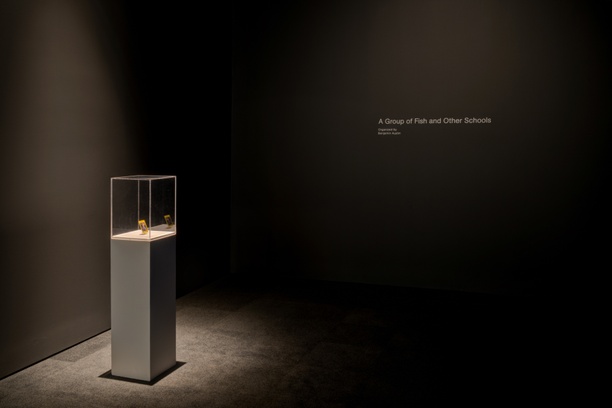
2016 Spring Exhibitions: Chapter 1
April 3 – April 24, 2016
→ Hessel Museum of Art
Exhibition Category
Collected exhibitions
The Center for Curatorial Studies presents exhibitions and projects curated by second-year students in its graduate program in curatorial studies and contemporary art. The students have organized these exhibition and projects as part of the requirements for the master of arts degree.
Student-curated exhibitions at CCS Bard are made possible with support from the Rebecca and Martin Eisenberg Student Exhibition Fund; the Mitzi and Warren Eisenberg Family Foundation; the Audrey and Sydney Irmas Charitable Foundation; the Robert Mapplethorpe Foundation; the Board of Governors of the Center for Curatorial Studies; the CCS Bard Arts Council; and by the Center’s Patrons, Supporters, and Friends.
Included exhibitions
A Group of Fish and Other Schools
Curated by Benjamin Austin

A Group of Fish and Other Schools provides an oblique portrait of a curator through strategies of presenting, representing, and dispersing this very figure. The aggregate image that is produced through the exhibition implicates CCS Bard in the proverbial curatorial fishbowl by asking: Who looks at whom and how do we learn by looking and selecting?
Doll's Eyes and Dimetrodon Tears
Curated by Linden Baierl

Doll’s Eyes and Dimetrodon Tears proposes a gentle stretching of life-death ontologies through a nexus of echoes between the animate and the inanimate, the human and the animal.
Emphasis Repeats*
Curated by Staci Bu Shea

What would it look like to practice affinity, to take care of the feelings, concepts, and forms that result from our relationship to those present and past? What if we considered affinity as integral to feminist methodologies?
Standard Forms
Curated by Christian Camacho-Light

Standard Forms considers aesthetic responses to the violence inflicted upon those bodies marked other by the nation-state’s regulatory norms and control mechanisms. Rather than representing these bodies directly, the works in the exhibition employ strategies of abstraction and non-figuration as a politics of form for rethinking the condition of the non-citizen.
Night Thoughts
Curated by Jody Graf

Night Thoughts coaxes a Romantic understanding of artistic voice out of the shadows of contemporary discourse while locating its critical potential in a metaphorical night. Distinctions between interiority and exposure, withdrawal and productivity, dreamer and critic, find themselves collapsed.
A Path of Safe Travel
Curated by Emma James

A Path of Safe Travel presents a selection of Oppenheimer’s drawings in order to trace aspects of her current research on the function of pivots and switches in networks of space. The exhibition is approached as a research process into Oppenheimer’s work, those of her colleagues and their shared references, to generate a series of conversations exploring the implications of Oppenheimer’s work across various components and support systems of exhibitionary practice, such as the floor plan, display, and threshold.
Timely Illuminations
Curated by Yanhan Peng

Timely Illuminations takes the histories of two pioneering Chinese photography publications, Modern Photography (1984-1993) and New Photo (1996-1998), as a starting point for examining artistic dialogues in China about transitional social and political contexts during the 1980s and 1990s.
The future will never arrive
Curated by Rachael Rakes

Presence is a phenomenological state of being in touch with the things, events, people, and feelings that make us who we are. The future will never arrive imagines history as being in a state of presence: always close, and always emergent. The exhibition examines artistic practices that conduct non-linear forms of historiography in order to make historical presence legible and affective.
objects are slow events
Curated by Alexis Wilkinson

objects are slow events brings together a group of artworks that appear still, but in fact, exist in a state of motion. Through imperceptible movements such as subtle vibrations, gradual material shifts, and protracted transfers of weight, the works explore stillness as a performative phenomenon.